The Toshiba TR200 3D NAND SSD Review: One Step Forward, One Step Back
by Billy Tallis on October 11, 2017 7:00 AM ESTAnandTech Storage Bench - Heavy
Our Heavy storage benchmark is proportionally more write-heavy than The Destroyer, but much shorter overall. The total writes in the Heavy test aren't enough to fill the drive, so performance never drops down to steady state. This test is far more representative of a power user's day to day usage, and is heavily influenced by the drive's peak performance. The Heavy workload test details can be found here. This test is run twice, once on a freshly erased drive and once after filling the drive with sequential writes.

All three capacities of the Toshiba TR200 are at the bottom of the chart for average data rate on the Heavy test, falling just below their predecessors. However, the TR200 is somewhat redeemed by retaining a lot of its performance even when full. In that case, the TR200 compares favorably against the HP S700 (the other DRAMless TLC SSD on the graph), and against the smaller capacities of the ADATA SU800.
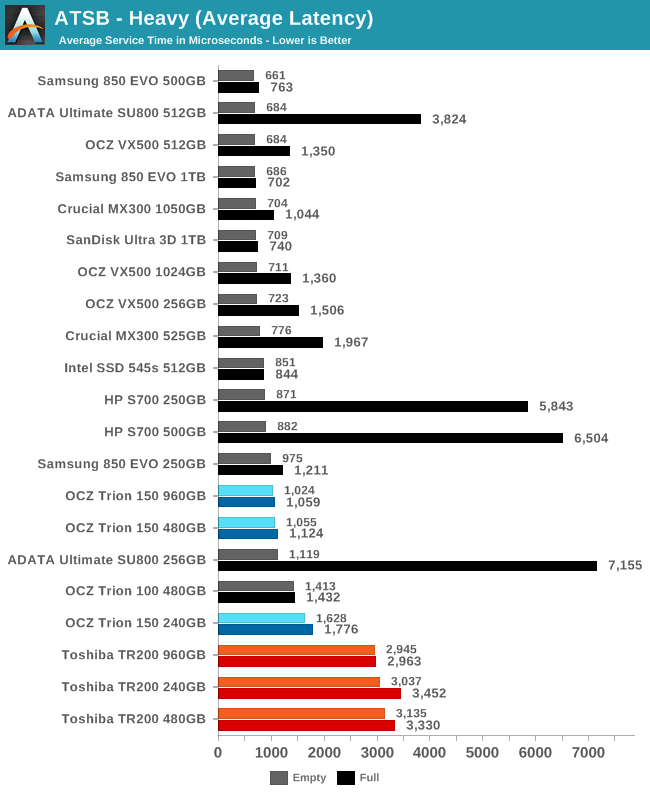
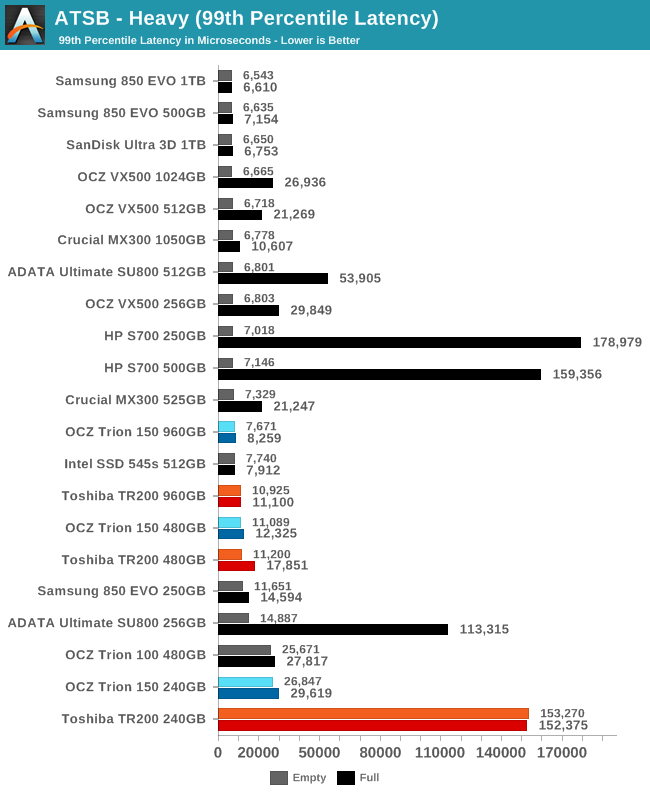
The average latency of the TR200 on the Heavy test is quite high for all capacities and whether the test is run on a full or empty drive. However, several other drives fare much worse when full.
When considering the 99th percentile latency, the 240GB TR200 stands out as having very poor QoS whether or not it is filled before running the Heavy test. The larger two models of the TR200 have rather high 99th percentile latencies, but don't fall too far outside the normal range. HP's S700 performs slightly worse when full, but even the 250GB model has decent control over latency when the test is run on an empty drive.
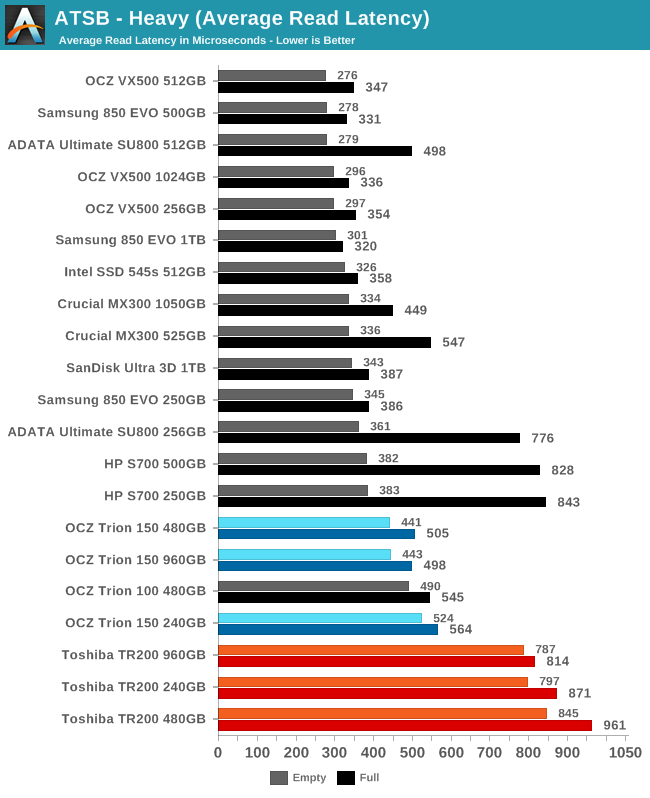
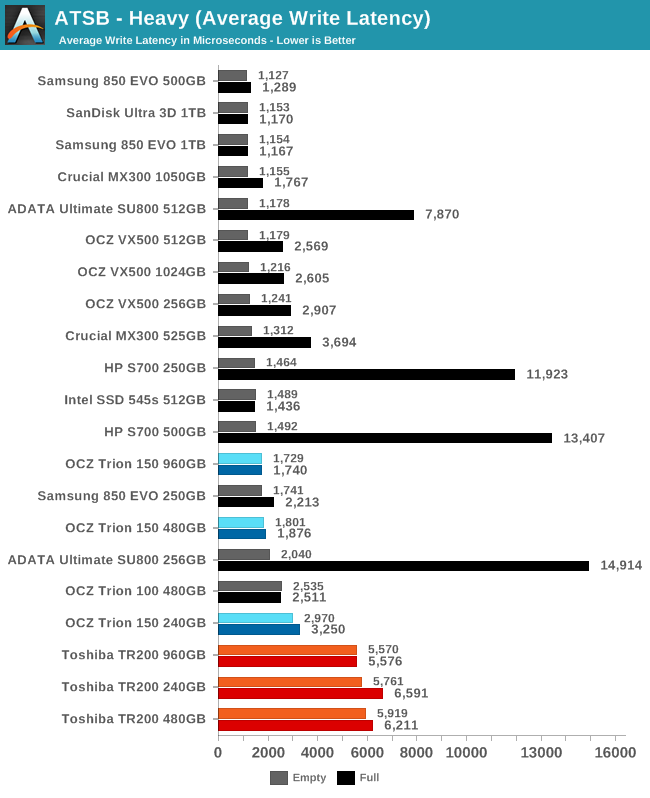
The average read and write latencies for the TR200 on the Heavy test stand out from the crowd. They're all slow, whether or not the drive is filled before running the test. There's not much variation between capacities and for both reads and writes the latencies are at least twice as high as most of the current competition. For reads, the TR200 is even worse than the ADATA SU800 and HP S700 at their worst, while for writes those drives have far higher latencies when full than the TR200.
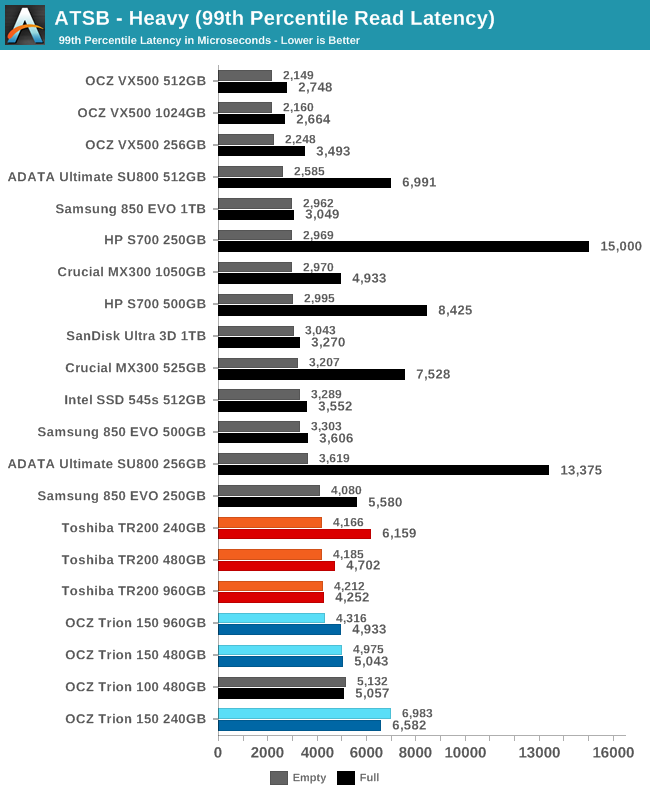
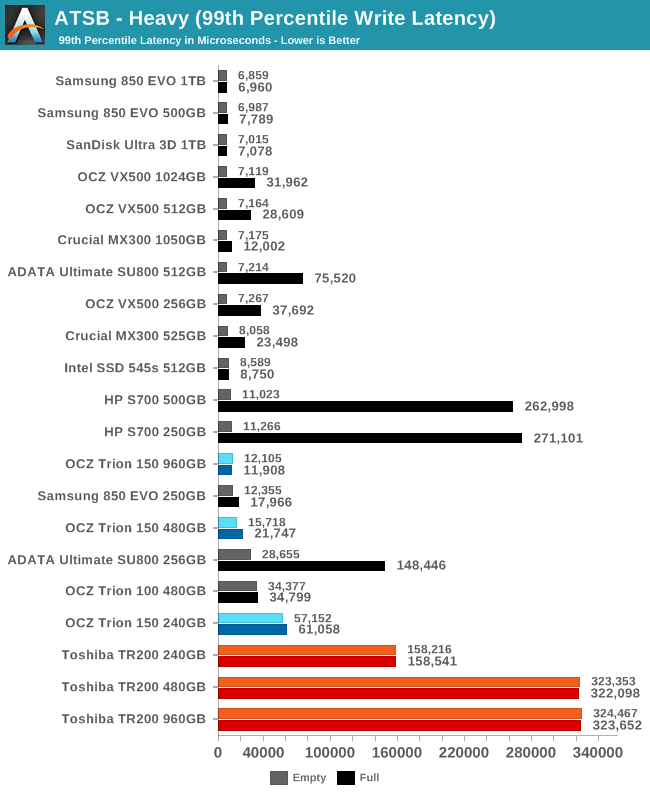
The 99th percentile read latencies of the TR200 are on the high side, but are not even twice as high as the best MLC drives, when the test is run on an empty drive. The smaller TR200s do a bit worse when the drive starts out full, but so do many other budget SSDs, and the 960GB model is barely affected. On the write side of things, there's no contest. The 99th percentile write latencies of the 480GB and 960GB TR200 are almost a third of a second. The 240GB model's 99th percentile latency is half as bad, but it's still unprecedented among recent models to see latency that bad even when the test is run on an empty drive.

When the Heavy test is run on an empty drive, the TR200 doesn't break any energy efficiency records, but it is competitive with some of the most efficient drives. When the drives are full, the TR200 takes the lead, thanks to the relatively small performance drop they show in that scenario. The TR200 has managed to cut energy use almost in half compared to its predecessors.










50 Comments
View All Comments
r3loaded - Wednesday, October 11, 2017 - link
Pwned by an 850 Evo but only $10 cheaper. Yay what a surprise.ddriver - Wednesday, October 11, 2017 - link
Cudos to toshiba for making an ssd that is as slow in sequential writes as a mechanical hdd. I can't imagine it was easy.It's a serious contender for "lousiest sata ssd of 2017".
masouth - Wednesday, October 11, 2017 - link
of just 2017?takeshi7 - Wednesday, October 11, 2017 - link
correction: slower than an hdd in sequential writes. But then again a lot of these cheap TLC drives have lower sustained write speed than HDDs. What really amazes me is that Toshiba actually made an SSD that's worse than the Crucial BX200. I never thought that would be possible.Samus - Wednesday, October 11, 2017 - link
At 1/10th the power consumption though. As hard as it is to defend this drive, it’s clear toshiba had a very specific goal in mind with this drive: cheap upgrades for cheap laptops. As an OEM supplier for many vendors (including even Apple) this drive is adequate for many sub-$500 laptops: being dramless makes power loss protection mostly unnecessary as it will likely recover from sram loss inside the controller, as the indirection table is mirrored off then back to the nand after each write.However, I’ve never been a fan of dramless controllers. Seams like a mind boggling corner to cut when the cost of 512mb DDR3 is $4.
Lolimaster - Wednesday, October 11, 2017 - link
Fact is Crucial MX300 is as cheap and way better, my way way way better,Samus - Sunday, October 15, 2017 - link
I've long stood by that assertion. Crucial and Samsung SSD's are the only mainstream drives worth considering. Sure, Sandisk, Intel, even Mushkin have their niche products, but Samsung and Crucial have no real "duds."Flunk - Wednesday, October 11, 2017 - link
Has Anandtech reviewed another budget SSD that's competitive with the 850 Evo, seems like that's the gold standard at the moment. I just bought one for my Mom for Christmas.theramenman - Wednesday, October 11, 2017 - link
The SanDisk Ultra 3D they reviewed a bit ago gets similar performance to a 850 Evo for $43 less (at least for the 1TB version).sonny73n - Thursday, October 12, 2017 - link
3 most valued SSD models currently on Amazon. One of them is the BX300 with capacity max out at 480GB which I can only compare it to the similar of the other 2.- Samsung 850 Evo 500GB $160
- SanDisk Ultra 3D 500GB $170
- Crucial BX300 480GB $145
The first 2 are made of TLC NAND and the BX300 is made of MLC. No brainer to pick the best one here.